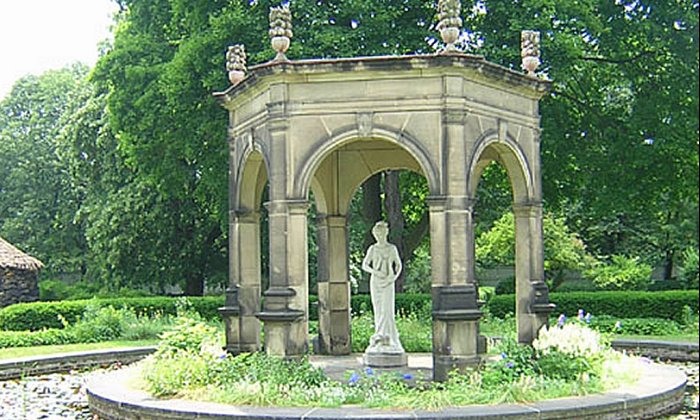A. Sutherland – AncientPages.com – Among the fabled objects in Greek mythology, a precious piece of jewelry is known to bring misfortune to all its owners or wearers. This mysterious object, made of gold and in the shape of two serpents adorned with precious jewels, is known as the Necklace of Harmony’.

Grotto (far left) and a statue of Harmonia in the Harmony Society gardens in Old Economy Village, Pennsylvania. Image credit: Lee Paxton – CC BY-SA 4.0
Tradition has it the Necklace brought a series of problems to people in any way related to it.
These people – primarily queens and princesses – represented the House of Thebes, which was thought to be the birthplace of a very significant member of the Greek pantheon.
The Necklace, which played an essential role in the epic known as the Theban cycle, was created by the will of god Hephaistos, who believed he had a right and a good reason to do it. Hephaistos learned that his legitimate wife, Aphrodite had a love affair with Ares, the god of war
This love affair was commonly known on Olympus and created ‘some’ embarrᴀssment and made Hephaistos unhappy and angry. He sought revenge for Aphrodite’s infidelity by dooming any lineage of children resulting from the affair she had with Ares.
One of Ares’ children with Aphrodite was Harmony (Harmonia, Roman counterpart, Discordia), the goddess of harmony and concord. The girl grew up and was later promised to Cadmus of Thebes, Cadmus of Thebes, who, according to Greek myths, was a brother of Europe, ancestor of Oedipus, and the founder of Thebes. Cadmus was also a Phoenician prince.
Harmony is not widely known as other divinities in Greek mythology. Still, her popularity is closely related to an ancient myth about the unfortunate Necklace she received on her wedding day.
Harmony and Cadmus’s royal engagement announcement gave Hephaistos an excellent opportunity to take revenge for his humiliations. Legend has it that during the wedding ceremony, Cadmus gave harmony a robe and a necklace (commonly known as the Necklace of Harmonia) which he had received either from Hephaestus or Europa.

Polynices giving Eriphyle the necklace of Harmonia. Attic red-figure oenochoe, ca. 450–440 BC. Found in Italy. Credit: Marie-Lan Nguyen – Public Domain
Cadmus did not know that the curse was still hanging over this piece of jewelry and the royalties of the House of Thebes. The god Hephaestus still remembered his wife’s betrayal and was determined to punish all her descendants with misfortune and tragedies, so it happened.
A Roman poet Hyginus (c. 64 BC–17 AD), gives another version of the gifts. According to him, it was a mysterious “dipped in crime” robe that brought misfortune to harmony’s descendants, not the Necklace. This fatal gift was given to Harmony by Hephaistos and Hera, but in another version, “Athena gave Harmonia a golden robe that endowed the wearer with dignity; during the ceremony.” 1
The Necklace then caused further accidents, scandals, and murders.
Harmonia and her husband were turned into serpents. Later, Zeus sent them to dwell among the happy immortals, either to the paradise in the Elysian Fields or the Islands of the Blest.
Next in line was the daughter of Harmony, Semele, who inherited the Necklace. She had no luck with it, either, because the ill-fated ‘treasure destroyed Semele. Wearing a necklace one day, Semele, Semele came in conflict with the goddess Hera, wife of Zeus, who wanted Semele to reveal her lover. However, it was very embarrᴀssing for the young woman because this lover was no other than Zeus in disguise. Semele foolishly demanded that Zeus prove himself and his power, which led to her destruction.
Even long after harmony’s death, the Necklace was still a dangerous object.
Finally, it was deposited among the treasures in the Temple of Athena in Delphi. But its disastrous nature appeared again when the Delphi temple was looted by Phayllus, one of the Phocian leaders in the Third Sacred War (356 BC-346 BC). He gave the Necklace to his mistress. After she had worn it for a time, her son was seized with madness and set fire to the house. She perished in flames along with all her worldly treasures.
It is probably the last story about the cursed Necklace of the goddess Harmonia.
Written by – A. Sutherland – AncientPages.com Senior Staff Writer
Updated on July 6, 2022
Copyright © AncientPages.com All rights reserved. This material may not be published, broadcast, rewritten or redistributed in whole or part without the express written permission of AncientPages.com
Expand for references
References:
- Monaghan P. Encyclopedia of Goddesses and Heroines Formulärets nederkant
Leeming, D. The Oxford Companion to World Mythology
The Library of Apollodorus, Gods, and Heroes of the Greeks





